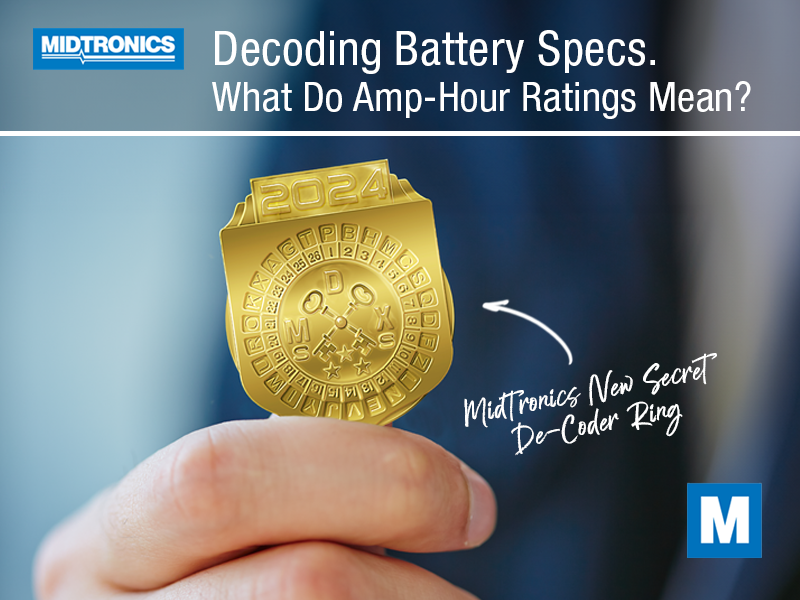While most drivers understand the importance of a healthy car battery, the jumble of letters and numbers on the label often remains a mystery. Among these specifications, the amp-hour (Ah) rating is a crucial number that directly impacts the performance and longevity of your battery.
Whether you’re a newer auto technician, support staff at a dealership service department, or you need a refresher on the basics of car battery specs, this post is for you. Learn what amp-hour ratings are about and why it’s important information when servicing or diagnosing vehicles.
Understanding Amp-Hour Ratings
An amp-hour rating is a unit utilized to measure the energy charge that a battery will hold. It is a critical piece of information when evaluating a battery’s capability to deliver current over a given period. For automotive batteries, an amp-hour rating tells us the number of hours the battery can put out a constant current without dropping below a specified voltage.
In simpler terms, higher amp-hour ratings typically mean a battery can run longer before it needs recharging.
Significance of Amp-Hour Ratings in Battery Performance
The amp-hour rating provides an estimate of how long a car battery can power the various systems in your vehicle without the engine running. Understanding this number is vital in scenarios where the alternator might be unable to charge the battery, such as extended idling or when the driver is using accessories with the ignition off.
Factors Impacting Amp-Hour Ratings
The amp-hour rating of a car battery is not set in stone. It is subject to various influences that can significantly alter how it operates. However, the battery that’s chosen for a particular application has a limited range of battery sizes due to physical limitation, not to mention that a vehicle needs an alternator capable of recharging its depleted stores.
Battery Size and Capacity
Larger batteries inherently have higher amp-hour ratings. This makes them better suited for vehicles with numerous power-hungry features, or for individuals who prioritize minimalistic electric consumption during engine-off periods. The constraint for size is that installing an oversized battery can be tricky, if at all possible, since the battery tray dimensions can’t be changed, nor can the clearance from the battery to the hood or panel above it.
Temperature Effects
Extreme temperatures can affect a battery’s chemical reactions, thereby impacting its capacity. Cold weather can reduce the battery’s amp-hour rating, explaining why difficulties starting a car are more prevalent during the winter. It’s also why vehicles have a battery with several times the capacity needed, so there’s always a certain amount of ‘wiggle room’ for cold starts and the like.
Discharge Rate
The rate at which a battery is discharged during usage will affect the actual amp-hour delivered. Rapid discharges lead to a lower actual or effective amp-hour rating than a slow, constant discharge. What that means is that the battery’s capacity to support electrical systems over a certain time frame without the support of the alternator is affected by the electrical demand exerted on it.
Interpreting Amp-Hour Ratings
Imagine you have two batteries with different amp-hour ratings, but need to know if it’s necessary to opt for the larger one. In a daily driving situation, knowing the typical amp-hour usage of your vehicle can help you determine which battery offers a better fit for your needs. But since the calculation can be prohibitive for anyone other than an automotive electrical expert, the best idea is always to recommend the higher-rated option within the correct battery size.
It’s about finding equilibrium. For example, if your vehicle’s systems draw a significant amount of power during a typical trip to work, a battery with a higher amp-hour rating is your best friend. If, however, you live in a warmer climate with less demand on the battery’s reserve capacity, you can make do with a lower rating.
Benefits of Knowing Amp-Hour Ratings
If it’s recommended to choose the higher amp-hour rating, why is it important to know about them?
With knowledge of amp-hour ratings, you can provide a battery that offers enhanced performance, ensuring the customer’s vehicle starts reliably in all conditions, and provide the best service.
- Understanding of test results – When the battery test results arrive, knowing how the rating is relevant to performance can aid you with interpreting the information for your customer. You’re more easily able to identify when there’s an issue, even without symptoms present.
- Prolonged battery life – Offering the right battery with an amp-hour rating suited to their use pattern can lead to a longer battery life, reducing the frequency of replacements and the impact on the environment.
- Cost-effective maintenance – By choosing a battery with a practical balance of cost and performance, users can help the consumer avoid pitfalls of both overpaying for excessive capacity and underestimating their daily energy needs.
- The perception of expertise – Customers are looking to you for expert advice, and they take peace of mind from it. If you and your staff are knowledgeable about terminology like amp-hour ratings, you position your shop as the best choice for servicing their vehicle in the future.
Conclusion
In the realm of automotive engineering, every number on a battery label has a purpose. The amp-hour rating is more than just a figure; it’s a predictor of a battery’s success in the real world. Along with terms like voltage, BCI battery group size, cold cranking amperage, and more, a knowledge of amp-hours is another tool in your toolbox to provide excellent service for your customers.




